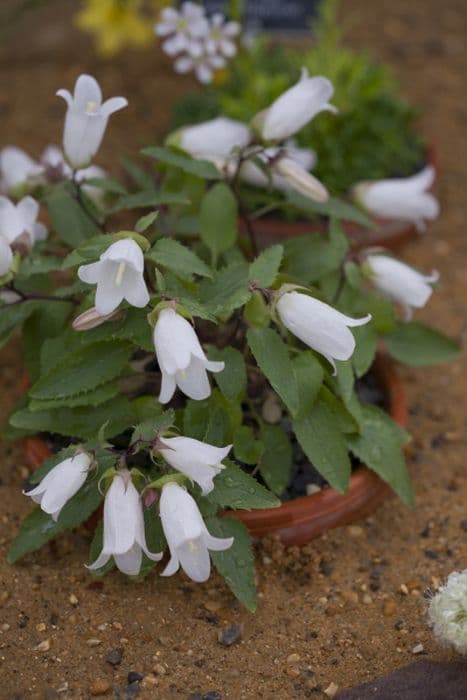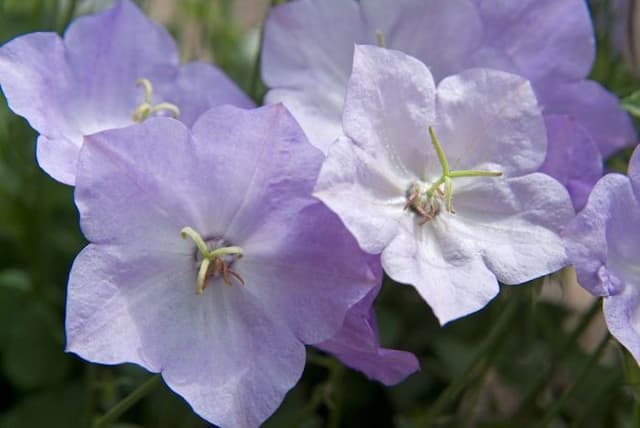Great bellflower Campanula latiloba 'Percy Piper'

ABOUT
The plant known as Percy Piper is characterized by its striking flowers which bear a resemblance to little bells or star-shaped blooms, a signature feature of its kind. These flowers are often a radiant violet or blue hue, adding a pop of vibrant color to gardens. The foliage is typically lush and green, providing a verdant backdrop for the blossoms. The leaves are often heart-shaped or lance-like, with a slight serration or a smooth edge, which creates a full and healthy appearance. The plant tends to form clumps, with stems that rise elegantly from the base, displaying the charming flowers that can be a delight to both human and pollinator visitors alike. Percy Piper blooms in the warmer months, presenting a cheerful facade that contrasts beautifully against the greenery.
About this plant
 Names
NamesFamily
Campanulaceae.
Synonyms
Percy Piper Bellflower, Wide-leaved Bellflower, Great Bellflower.
Common names
Campanula latiloba 'Percy Piper'.
 Toxicity
ToxicityTo humans
The plant in question is a variety of bellflower, and generally, bellflowers (Campanula species) are not known to be toxic to humans. There are no well-documented cases of poisoning from ingesting this plant, and it is usually considered safe to handle and have in gardens where humans, including children, have access. However, as with any plant, individual allergic reactions can occur, and proper caution should always be exercised when handling any plant if you are not familiar with its effects.
To pets
The plant known as bellflower, including varieties like Campanula latiloba 'Percy Piper', is not commonly listed as toxic to pets such as cats and dogs. The bellflower is generally considered non-toxic and safe for pets if they happen to ingest small quantities. However, each pet is different, and some may exhibit individual sensitivities or allergic reactions. It is always best to discourage pets from eating plants, and to monitor for any signs of distress, such as gastrointestinal upset, even from non-toxic plants. If any unusual symptoms do arise after ingestion, it is advisable to consult a veterinarian.
 Characteristics
CharacteristicsLife cycle
Perennials
Foliage type
Deciduous
Color of leaves
Green
Flower color
Lavender
Height
2 feet (60 cm)
Spread
1.5 feet (45 cm)
Plant type
Herb
Hardiness zones
3
Native area
Europe
Benefits
 General Benefits
General Benefits- Attractive Flowers - Produces striking, bell-shaped lavender flowers that enhance garden aesthetics.
- Pollinator-Friendly - Attracts bees, butterflies, and other pollinators, supporting local ecosystems.
- Low Maintenance - Requires minimal care once established, making it suitable for busy gardeners.
- Drought Tolerance - Can withstand periods of low water, ideal for xeriscaping or drought-prone regions.
- Long Blooming Period - Offers a lengthy display of blooms from early to late summer.
- Rustic Charm - Adds a cottage garden feel to landscapes with its informal appearance.
- Borders and Beds - Works well in mixed borders or perennial beds, providing structure and color.
- Resilience - Shows good resistance to common pests and diseases, ensuring robust growth.
- Cut Flowers - Makes an excellent choice for fresh floral arrangements thanks to its attractive blooms.
- Ground Cover - Can be used to fill in bare spots and reduce weed growth, given its spreading habit.
 Medical Properties
Medical PropertiesThis plant is not used for medical purposes.
 Air-purifying Qualities
Air-purifying QualitiesThis plant is not specifically known for air purifying qualities.
 Other Uses
Other Uses- Photography backdrop: The attractive blooms of the bellflower make it an excellent choice for photographers seeking to enhance their natural setting or portrait backgrounds.
- Educational tool: Botany educators may use the bellflower to teach students about pollination and the structure of angiosperms in a hands-on outdoor classroom.
- Natural dye: The petals of the bellflower can be used to create natural dyes for textiles, providing a range of soft blue and violet hues.
- Edible decoration: Although less common, the flowers of the bellflower can be used to decorate cakes and desserts after verifying they are free from pesticides and safe for consumption.
- Garden architecture: Tall varieties of the bellflower can be used to add vertical interest in garden designs, as their height can create a beautiful structural element.
- Pressing and preserving: The blooms of the bellflower can be pressed and preserved in books or frames, often used in crafting or as botanical art.
- Themed gardens: Bellflowers can be included in "blue-themed" or "fairy-tale" garden designs to create a specific ambiance or aesthetic theme.
- Artistic inspiration: Artists may use bellflowers as a subject in paintings, drawings, and other art forms due to their unique shape and beauty.
- Seasonal crafts: The dried seed heads of the bellflower can be used in dried floral arrangements or seasonal crafts, such as wreaths.
- Companion planting: Bellflowers can be strategically placed in a vegetable garden to attract beneficial insects that assist in the pollination of crops.
Interesting Facts
 Feng Shui
Feng ShuiThe Bellflower is not used in Feng Shui practice.
 Zodiac Sign Compitability
Zodiac Sign CompitabilityThe Bellflower is not used in astrology practice.
 Plant Symbolism
Plant Symbolism- Gratitude - Campanula, commonly known as bellflower, often symbolizes gratitude due to its bell shape that is reminiscent of people bowing to express thanks.
- Constancy and Perseverance - The bellflower's ability to grow in various conditions and its propensity to return each year can represent steadfastness and durability in relationships and endeavors.
- Unwavering Love - With its enduring and long-lasting nature, the bellflower can signify everlasting love and devotion.
- Humility - The bell shape hanging downward reminds us of humility and the act of reflecting inwardly.
 Water
WaterThe Great Bellflower prefers consistent moisture, so it's important to water it when the top inch of soil feels dry. Generally, this equates to watering once or twice a week, depending on climate conditions and the plant's environment. Each watering session should thoroughly soak the soil, which can mean using approximately 1-2 gallons of water for an outdoor garden plant, ensuring water penetrates deeply into the root zone. During hotter, drier periods, water frequency may need to increase, while in cooler, wetter months, it can decrease. Always avoid overhead watering to prevent leaf diseases and instead water directly at the soil level.
 Light
LightThe Great Bellflower thrives best in full sun to partial shade conditions. Ideally, it should be planted in a spot where it can receive at least 4-6 hours of sunlight each day. However, in extremely hot climates, some afternoon shade can be beneficial to protect the plant from intense, direct sunlight.
 Temperature
TemperatureThe Great Bellflower is hardy and can withstand temperatures down to about -30 degrees Fahrenheit but performs best in temperate conditions. The ideal growing temperature range is between 50 degrees and 70 degrees Fahrenheit. It's important to protect the plant from extreme heat or cold to maintain its health and flowering capabilities.
 Pruning
PruningThe Great Bellflower should be pruned to remove spent flowers and encourage a second bloom. Also, pruning is necessary to maintain its shape and remove any damaged or diseased foliage. The best time for pruning is immediately after the first flush of flowers has faded, typically in midsummer. This could be done every year to promote vigorous growth and better flowering in the next season.
 Cleaning
CleaningAs needed
 Soil
SoilGreat Bellflower ('Percy Piper') thrives in well-draining soil rich in organic matter with a pH ranging from 6.0 to 8.0. A mixture of garden soil, compost, and perlite or sand to improve drainage is recommended. To maintain the ideal pH and nutrient levels, yearly mulching with compost can be beneficial.
 Repotting
RepottingGreat Bellflower ('Percy Piper') typically does not need frequent repotting and can thrive for several years in the same spot. If grown in a container, repotting every two to three years is advisable to refresh the soil and address any nutrient deficiencies.
 Humidity & Misting
Humidity & MistingThe Great Bellflower ('Percy Piper') is tolerant of a range of humidity levels but prefers average to slightly above-average humidity levels. It does not require specific humidity control measures when grown outdoors in suitable climates.
 Suitable locations
Suitable locationsIndoor
Ensure bright light, well-draining soil and regular watering.
Outdoor
Plant in sun to part-shade, in fertile, well-drained soil.
Hardiness zone
3-9 USDA
 Life cycle
Life cycleCampanula latiloba 'Percy Piper', commonly known as the broad-leaved bellflower, begins its life as a seed, which germinates in moist but well-drained soil in the spring. After sprouting, the seedling grows into a rosette of basal leaves, focusing on establishing a strong root system. As the plant matures, it develops upright stems with alternate leaves, leading to its characteristic flowering stage in early to mid-summer, showcasing its bell-shaped, lavender-blue flowers. Following pollination by insects attracted to the blooms, the plant sets seed in late summer, which can be dispersed for reproduction or collected for cultivation. Through fall and into winter, the broad-leaved bellflower enters a period of dormancy, with the aerial parts dying back, while the roots remain alive to survive the cold. In the subsequent spring, the plant re-emerges from its rootstock to complete another life cycle.
 Propogation
PropogationPropogation time
Early Spring
Propogation: Campanula latiloba 'Percy Piper', commonly known as the great bellflower, is typically propagated in the spring or early summer. The most popular method of propagation for this perennial plant is by division. To propagate by division, you carefully dig up an established clump of the plant and gently separate it into smaller sections, ensuring that each division has a good portion of the root system intact. These sections are then replanted in well-prepared soil, spaced appropriately to allow for growth. Ideal planting should be done on a cool, cloudy day to reduce stress on the plants. Water the new divisions thoroughly after planting to help establish them. This method is simple, efficient, and helps to rejuvenate older clumps that may have become woody or less vigorous.









![Milky bellflower [Avalanche]](/_next/image?url=https%3A%2F%2Fplants-admin.emdemapps.com%2Fimages%2Fplants%2F%2Fimages%2F604b5dc88c1e7.png&w=640&q=75)